Table of Contents
- Overview
- Editor’s Choice
- What is Remote Patient Monitoring?
- Remote Patient Monitoring General Statistics
- Remote Patient Monitoring User Statistics
- Wearable Devices in Remote Patient Monitoring
- Role of Telemedicine in Remote Patient Monitoring Statistics
- AI in Remote Patient Monitoring, by Application Statistics
- Remote Patient Monitoring, by Country Statistics
- Recent Developments
- Wrap Up
- FAQs
Overview
Remote Patient Monitoring Statistics: Remote patient monitoring (RPM) refers to using technology to collect health data from individuals outside traditional healthcare settings and transmit this data back to healthcare providers for analysis and monitoring.
RPM allows healthcare professionals to track patients’ conditions remotely, monitor vital signs, and manage chronic illnesses without frequent in-person visits.
Remote patient monitoring statistics will help you to show how technological advancements are emerging in the healthcare sector.
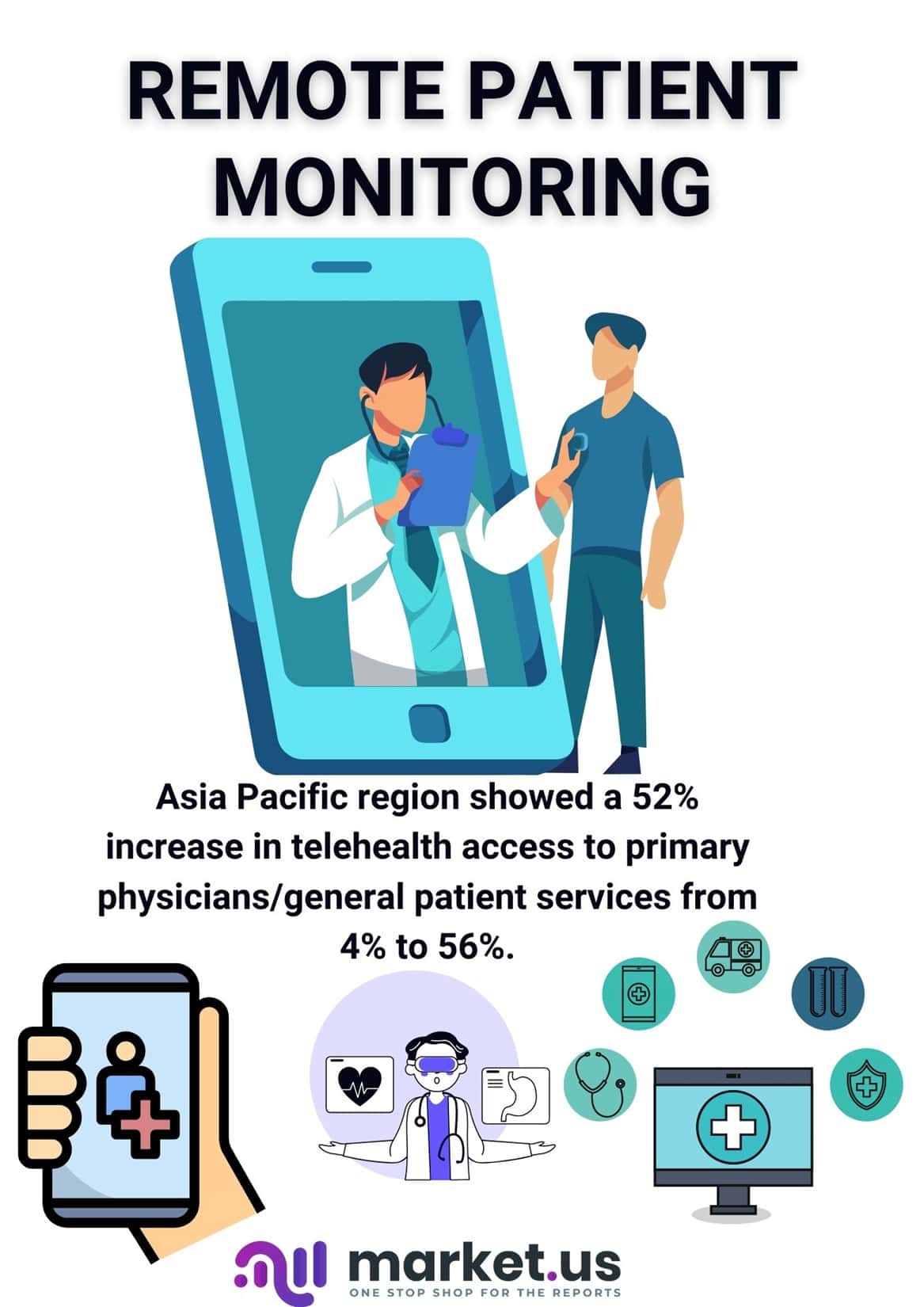
Editor’s Choice
- 23.4 million U.S. patients will utilize remote patient monitoring services and tools in 2022.
- By 2024, remote patient monitoring services and tools are expected to reach 30 million U.S. patients.
- 80% of Americans favor remote patient monitoring and more than one-half are strongly supportive of incorporating it into medical care services.
- 88% of patients surveyed reported having access to remote healthcare in the past year.
- 9 out of 10 healthcare providers polled had indicated they already invested in remote patient monitoring technologies.
- Physicians’ perceptions that digital health tools benefit patient care increased from 85% in 2016 to 93% by 2022 – and this increase can be observed regardless of physician age or specialty.
- 70% of medical professionals rated telemedicine in the COVID-19 pandemic.
- Asia Pacific region showed a 52% increase in telehealth access to primary physicians/general patient services from 4% to 56%.
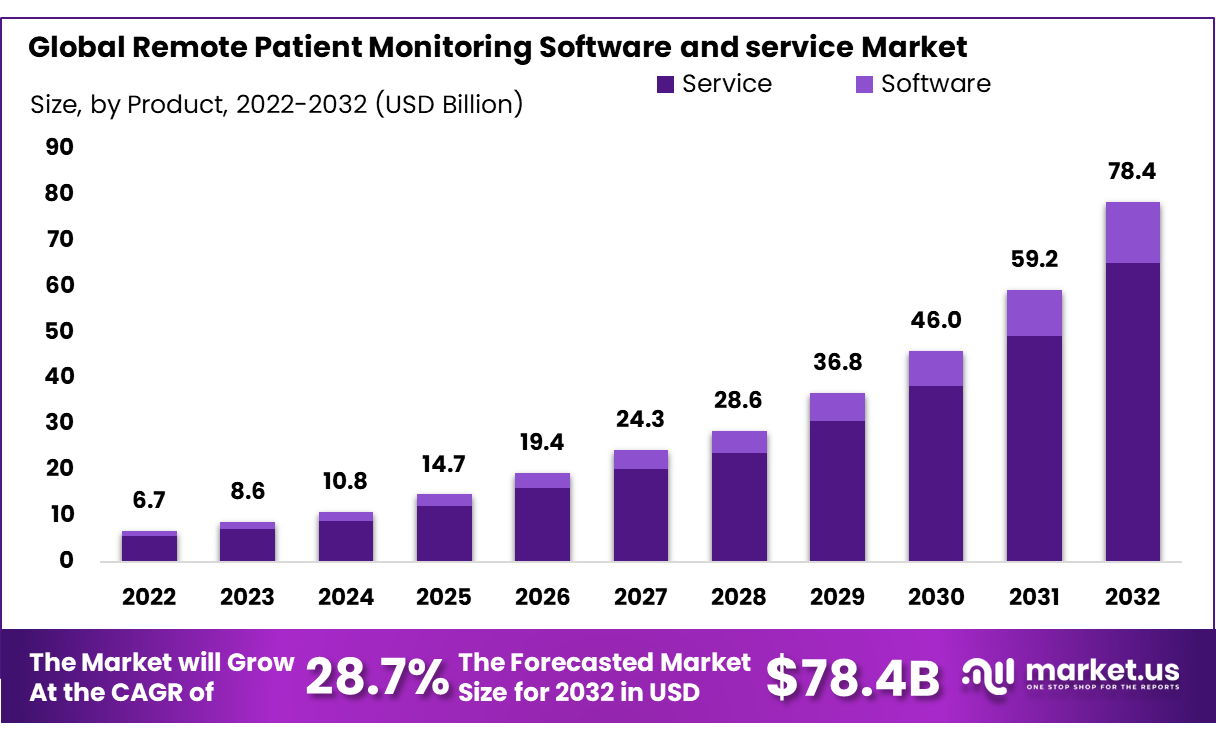
What is Remote Patient Monitoring?
Remote Patient Monitoring (RPM) refers to the use of technology and healthcare devices to remotely assess patients’ health status and collect medical data without their having to visit healthcare facilities themselves.
RPM enables healthcare providers to keep tabs on patients, track symptoms remotely, and collect real-time health data remotely from distant locations.
Remote Patient Monitoring General Statistics
- According to research conducted, over 23 million patients were already using remote patient monitoring tools and services by 2020; with this number expected to surpass 30 million people by 2024.
- Virtual visits conducted by physicians rose from 14% in 2016 to 80% by 2022, and remote monitoring devices more than doubled from 12% in 2016 to 30% by 2022.
- University of Pittsburgh Medical Center achieved patient satisfaction scores exceeding 90% by equipping its patients with remote patient monitoring equipment and tablets.
- More than 25% of consumers stated that they would shift to a new physician to access healthcare.
- Remote patient monitoring reduces hospital admissions by 38% and emergency room visits by 51%.
- According to a survey conducted by Spyglass Consulting Group, it is found that 88% of healthcare providers believed that remote patient monitoring improves patient outcomes.
- According to a study published in the Journal of Medical Internet Research: the patients using monitoring devices reported higher levels of satisfaction and felt more empowered in managing their healthcare conditions.
- It is expected that remote patient monitoring can save the healthcare industry up to USD 200 billion over the next 25 years.
- According to the Centers for Medicare and Medicaid Services (CMS), approximately 150,000 patients are enrolled in remote patient monitoring programs in the United States, and this number is growing continuously.
(Source: Nonagon, JAMA Internal Medicine)
Remote Patient Monitoring User Statistics
- In 2020, about 29.1 million individuals in the United States were using remote patient monitoring systems, this number is expected to grow to 709.6 million in 2024 with 16% more as compared to 2020.
- According to the report by the University of Pittsburgh Medical Center RPM reduces the risks of hospital readmission by 76%. Also, the report stated that about 90% of users are satisfied with using remote patient monitoring services.
- A KLAS Research report surveyed 25 healthcare organizations, and it was found that 38% of healthcare organizations running RPM programs to provide chronic care management.
- RPM technology engagement rates reached 78.9% in 2021. Emergency department visit and hospitalization rates within 30 days of enrolment ranged between 11.4% and 9.4%; while the 30-day mortality rate stood at 0.4%.
(Source: npj)
Take advantage of our unbeatable offer - buy now!

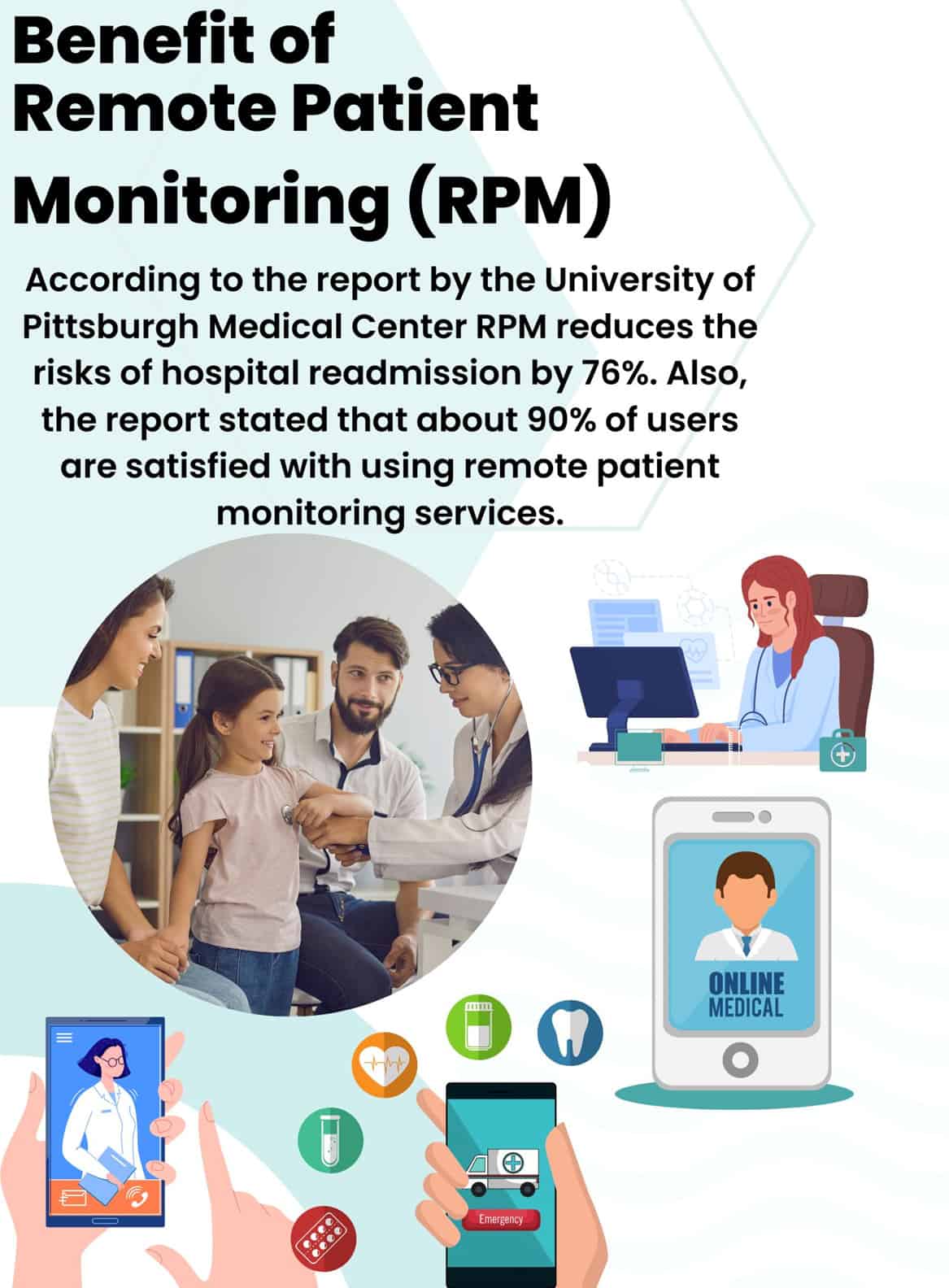
Wearable Devices in Remote Patient Monitoring
RPM devices have gained popularity in recent years due to their potential to improve patient care, increase access to healthcare, and reduce healthcare costs.
Remote patient monitoring (RPM) devices are used to collect and transmit medical data from patients to healthcare providers without the need for in-person visits.
Wearable devices play an important role in remote patient monitoring by providing continuous and real-time monitoring of various health parameters.
- 25% of women use this healthcare device regularly.
- Approximately 30% (1266 out of 4551) of the adult population utilize wearable healthcare devices.
- The most likely groups to report using wearable healthcare devices were women 16.25%.
- According to a study, 69% of Americans would be willing to wear a smartwatch if it resulted in a reduction in their insurance premium. Among these individuals, 46% were prepared to share their data.
- 88% of physicians want patients to monitor their health parameters at home.
- Nearly 50% of users are dependent on wearable technology in daily life, with more than 80% of users willing to share their data with their healthcare providers.
- Number of connected wearable devices worldwide is rising from 325 million in 2016 to 722 million in 2019.
- According to Deloitte Insights, the global market of wearable devices for the medical sector is booming. Compared to 275 million units in 2021, it is projected to reach nearly 440 million units in 2024.
- Wearable technology could drop hospital costs by as much as 16% over 5 years, and remote patient monitoring technologies could save our healthcare system $200 billion over the next 25 years.
- About 63% of the US population uses fitness trackers.
(Source: vicert, Statista, velvetech, emedcert)
Role of Telemedicine in Remote Patient Monitoring Statistics
Telemedicine plays an important role in remote patient monitoring (RPM) by enabling healthcare providers to connect with patients virtually and deliver care remotely.
This reduces the need for in-person visits. By using video conferencing platforms, healthcare providers can remotely access patients’ health conditions, discuss symptoms, review tests, and provide medical advice.
- According to the report by McKinsey, telehealth usage in the United States increased from 11% of Americans in 2019 to 46% in 2020 during the COVID-19 pandemic.
- According to the report by the American Medical Association (AMA), in 2022, approximately 83% of doctors in the United States were providing telehealth services, as compared to just 22% in 2019.
- Telemedicine and Remote Patient Monitoring (RPM) have the potential to reduce healthcare costs. According to a study published in the Journal of Medical Economics, it is found that remote monitoring reduces healthcare costs by 53%, resulting in cost savings of approximately USD 8,375 per patient over six months.
- According to market.us, the global telemedicine market size is expected to be worth around USD 590.9 Bn by 2032 from USD 63.5 Bn in 2022, growing at a CAGR of 25.7% during the forecast period from 2022 to 2032.
- The North American region is dominant in the global telemedicine market, with the largest market revenue of USD 22.8 billion.
(Source: Market.us)
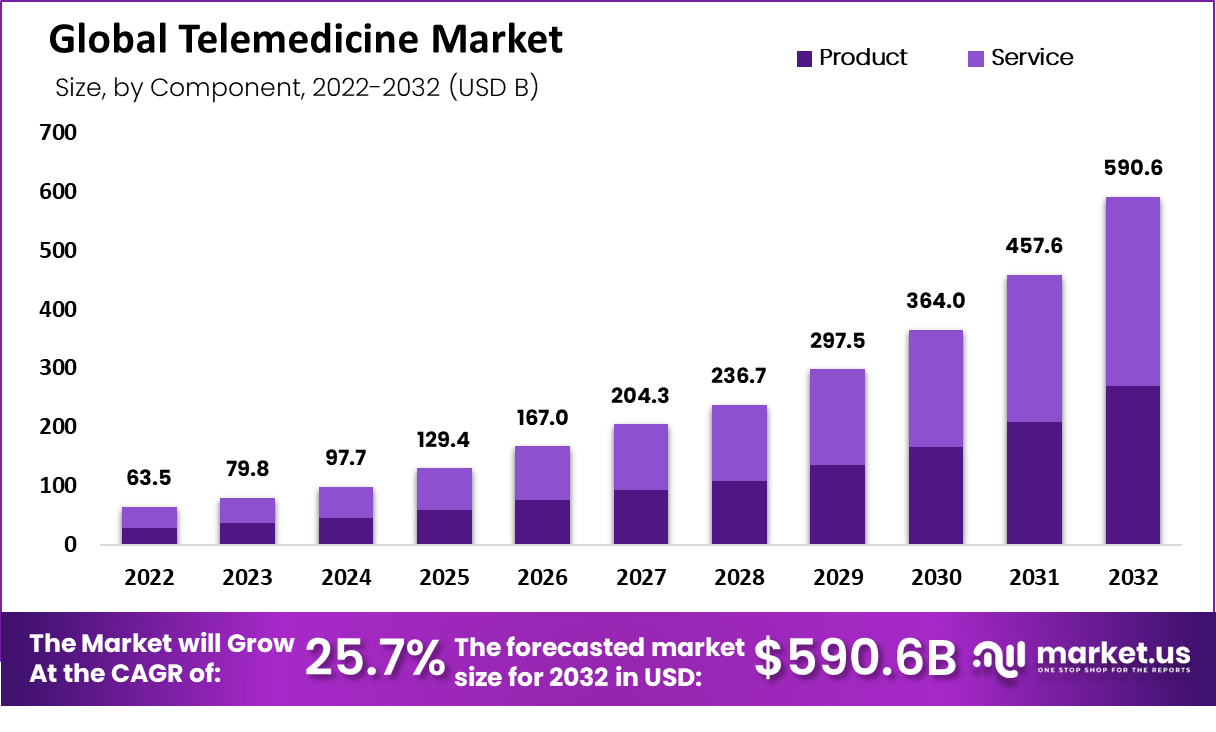
According to a study by Rock Health,
- 20% of the respondents reported no prior telemedicine use.
- 44% of respondents indicated that they prefer to discuss health in person.
- 57% of people use live phone telemedicine.
- 48% of individuals prefer health apps or websites for prescriptions.
- 43% of respondents prefer emails.
- 36% of users prefer text messages for a prescription.

AI in Remote Patient Monitoring, by Application Statistics
Artificial Intelligence (AI) plays a significant role in enhancing remote patient monitoring by enabling advanced data analysis, productive modeling, and decision support.
RPM utilizes various devices such as sensors, wearables, smart devices, and home monitoring systems to gather healthcare data.
AI algorithms can continuously monitor patient data in real-time enabling healthcare providers to detect abnormalities or changes in the patient’s health status promptly.
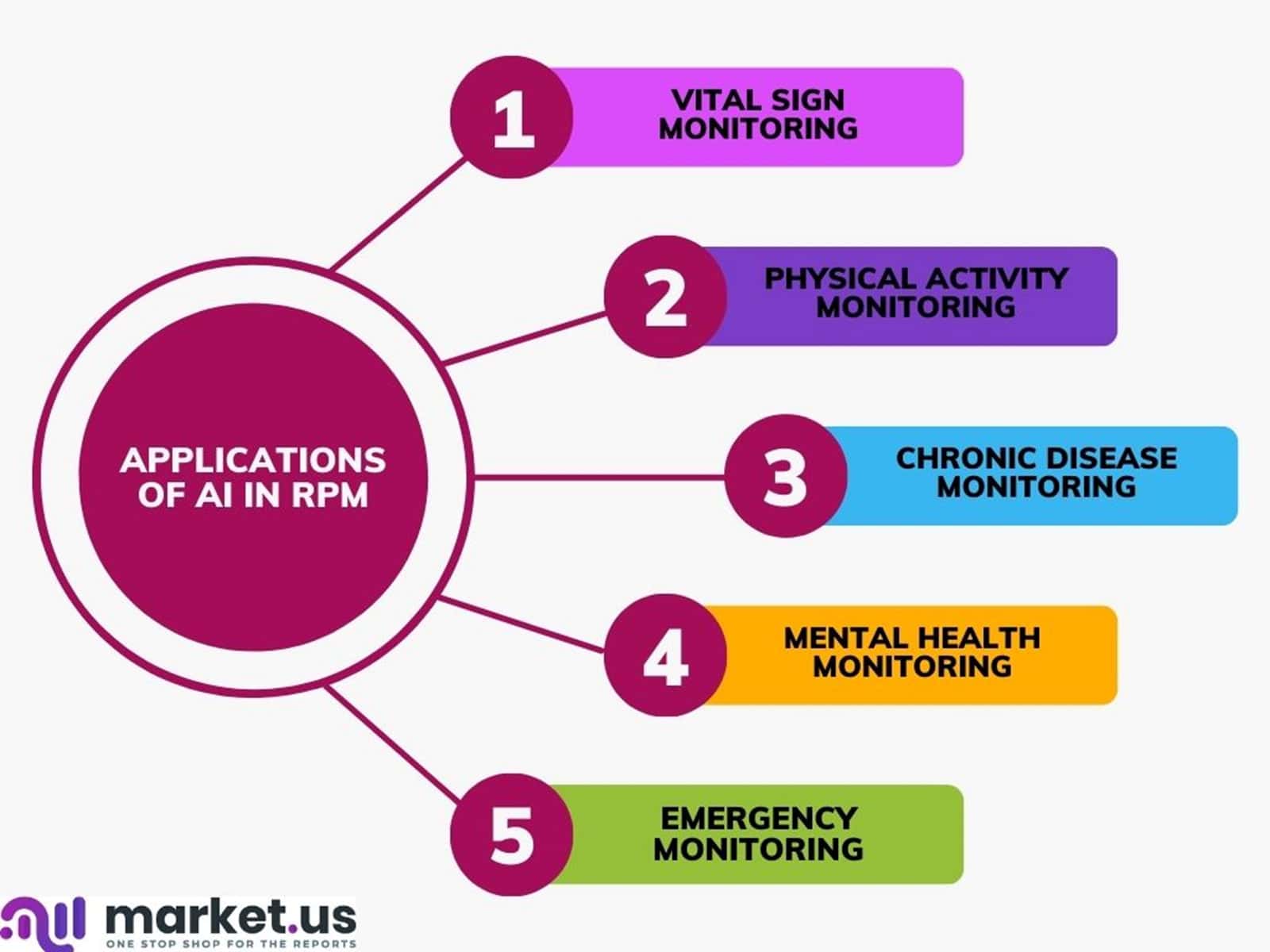
In RPM applications, traditional machine learning and deep learning are common AI methods adopted to detect any predictive vital signs and classify patients’ physical activities. This section shows the application of machine learning and deep learning methodologies in RPM.
The year-wise distribution of the AI-enabled RPM works discussed in this section is presented in Figure:
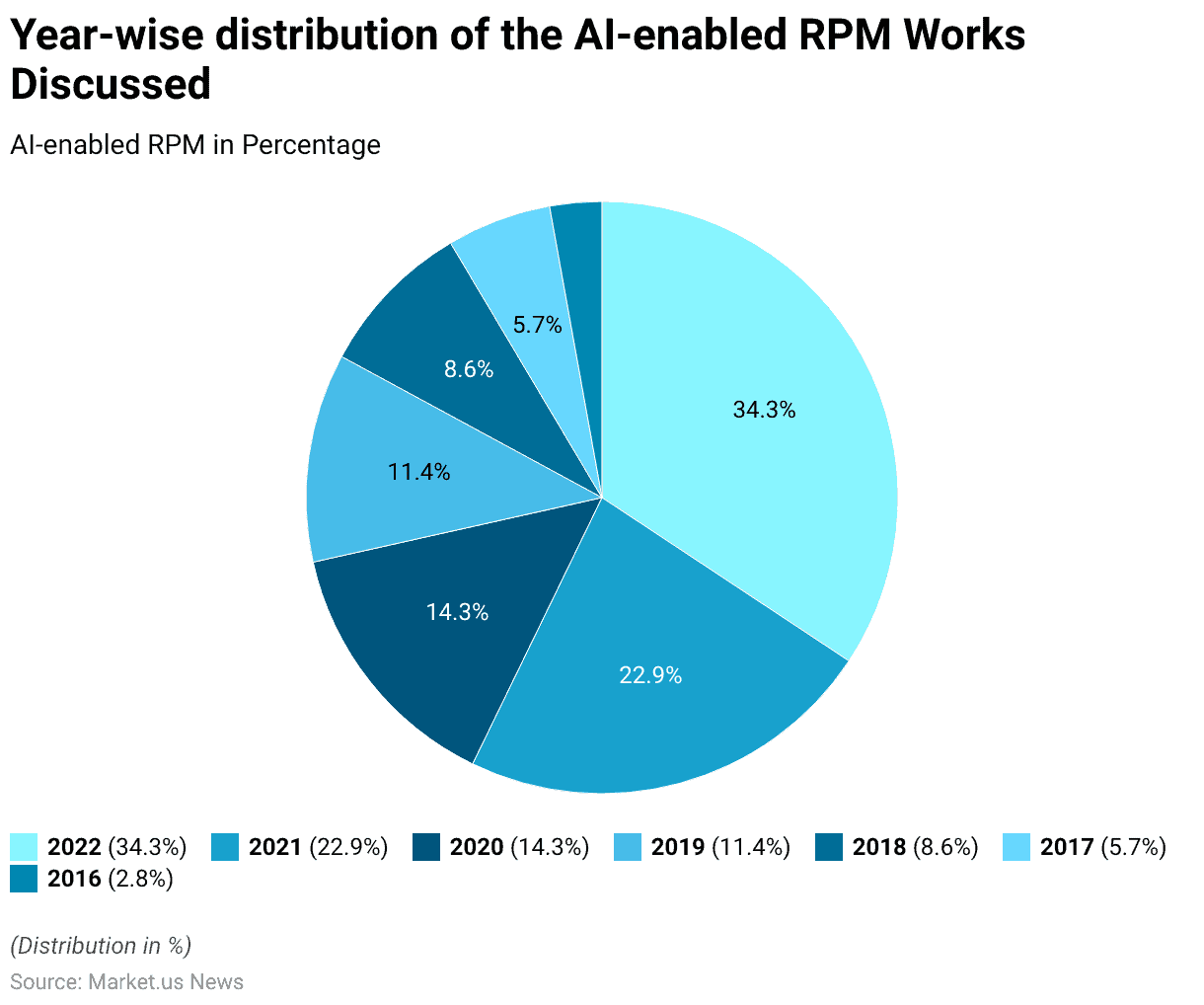
Vital Signs Monitoring
The Healthcare wearables like smartwatches and new advanced technologies help individuals to track their vital signs.
Smartwatches collect the healthcare data of individuals and send it to a healthcare provider to analyze health conditions.
- Healthcare administrators use the SVM model to build decision models. The machine learning model has an accuracy of 90% and a recall is 99%.
- SVM systems based on AI and machine learning can identify 99% of patients affected by cardiovascular diseases.
- Shao et al. also have an AI-based system that is designed to detect ECG signals with an accuracy of 95%.
- The catBoost model processed the 30-second ECG data quickly in under half a second and achieved a 99.61% sensitivity, 99.64% specificity, and an accuracy rating of 99.62% in detecting Atrial Fibrillation.
- A novel- IoT-based wearables 12-lead ECG SmartVest system which is based on the SVM model to access healthcare signal quality has an average accuracy of 97.9% and 96.4%.
- The proposed classification model attained an effectiveness rate of 88.9% for statistical features, 90.8% for HRV features, and 92.2% for combined statistical and HRV features respectively.
- Multilayer perceptron (MLP) neural network (MLP) classifiers have an average accuracy of 96.48%, a sensitivity of 98.70%, and a specificity of 94.45%.
(Source: wires)
Vital signs monitoring with artificial intelligence
| Applications | Algorithm | Technology |
| Vital Sign Monitoring | Support Vector Machine (SVM), RF, | Sensors, RFID Tags |
| Wearable Accelerometer |
Physical Activities Monitoring
Physical activity monitoring systems such as Pan et al. designed a fall detection system for older people based on multisensory.
The fragment modification algorithm adopts rule-based fall identification and five machine learning techniques, SVM, KNN, naive Bayes, decision tree, and adaptive boosting to identify the five phases. Out of five machine learning techniques:
- KNN algorithm achieved the best performance with an accuracy of 90.28%, sensitivity of 82.17%, and precision of 85.74%.
- The LSTM identified falls from daily activities with a high accuracy of 96.78%, while sensitivity and specificity were 97.87%, and 95.21%, respectively.
(Source: wires)
Human activity recognition with artificial intelligence
| Applications | Algorithm | Technology |
| Physical Activity Monitoring | Support Vector Machine (SVM), | Smartwatches, Smart Vest, ECG Telemetry |
| Portable ECG Devices, Sensors, Radar Devices |
Remote Patient Monitoring, by Country Statistics
The implementation and availability of remote patient monitoring can vary by country due to factors such as healthcare infrastructure, regulations, and technological adoption.
United States
The United States has been at the forefront of RPM adoption, with various initiatives and programs implemented to promote remote patient monitoring.
The United States has a strong healthcare infrastructure and a significant number of RPM companies and start-ups.
- Telemedicine use increased with age and was higher among women (42.0%) compared with men (31.7%).
- The percentage of adults who used telemedicine increased with education level and varied by family income.
- 52% of American adults reported usage of telemedicine through live video calls with their healthcare providers.
- The United States telemedicine market is expected to reach a revenue of USD 22 billion by 2025.
- According to a survey carried out among U.S. physicians, about 65% of respondents had not used telehealth before the COVID-19 pandemic. During the peak of the COVID-19 pandemic, 43% of physicians were seeing over 50% of their patients via remote health monitoring technology.
(Source: Statista, cdc.gov)
Canada
Remote patient monitoring and telemedicine have gained significant traction in Canada as a means to improve patient care, especially for individuals living in remote or underserved areas.
- In 2021, a survey of physicians in Canada, it is found that about 84% of physicians reported they believed that virtual care improves patients’ access to care.
- 75% of physicians stated that virtual care enabled physicians to provide more efficient care.
- There are about 17.7 million eHealth users in Canada in 2021, and this number is expected to grow to 21 million users in eHealth by 2026.
- According to the Canadian Medical Association, 41% of Canadians would like to have video visits with their healthcare provider, as compared to 4% of family physicians who offer this option in Canada.
(Source: Statista)
United Kingdom
The United Kingdom actively exploring and implementing remote patient monitoring solutions to improve healthcare outcomes.
The Australian government has been investing in telehealth and RPM initiatives, particularly to improve healthcare access in rural and remote areas.
- According to a survey by the Office for National Statistics (ONS) conducted in 2021, around 26% of adults in Great Britain had used remote consultations with their healthcare providers.
- As of September 2021, more than 80% of GP practices and 95% of pharmacies in England were using Electronic Prescription Services.
- According to the NHS Digital Apps Library, there were more than 480 apps listed in 2021, covering various health-related topics such as mental health and chronic disease management.
- In 2020, UK digital health start-ups raised over USD 500 million in funding.
- In 2020 alone, there were 1.2 million telehealth appointments in the United Kingdom.
- According to NHS, there were about 88% of patients used telehealth services in 2020.
(Source: ONS)
Germany
The German government has been promoting telemedicine and e-health initiatives to make revolutionary changes in the healthcare sector in Germany.
- According to a survey of eHealth professionals in Germany, about 23% of healthcare organizations provide telehealth services and solutions, as compared to 20% of healthcare organizations that provide live video consulting telehealth services.
- The revenue of the digital health market in Germany is projected to reach USD 4.30 billion in 2023.
- Online doctor consultations gained significant demand in Germany, and the revenue in online doctor consultation is expected to reach a revenue of USD 0.69 billion in 2023, with a Compound Annual Growth rate (CAGR) of 6.48%.
(Source: Statista)
China
China is rapidly adopting digital health technologies, including remote patient monitoring. The country’s large population and expanding middle class have created a demand for innovative healthcare solutions.
- As of December 2022, more than 363 million individuals in China have used online medical services (About 34% of the total population).
- Ping An Good Doctor was the leading online healthcare service provider in the market in China with the largest number of active users almost 23 million as of December 2022.
- About 84% of clinicians in China believe that in the coming 10 years’ patients will have easy access to remote monitoring tools to assess their healthcare and well-being.
(Source: Statista)
Recent Developments
Acquisitions and Mergers:
- HealthTech Solutions acquired RemoteCare Technologies for $200 million, expanding its portfolio of remote patient monitoring solutions and enhancing its capabilities in telehealth services.
- TeleHealth Innovations merged with RemoteHealth Systems, forming a strategic partnership to develop integrated remote patient monitoring platforms, with combined resources facilitating seamless patient care coordination.
New Product Launches:
- CareGuard introduced a wearable remote monitoring device for elderly patients, offering real-time vital signs tracking and fall detection capabilities, aiming to reach 100,000 units sold within the first year.
- HealthTrack launched a mobile app for remote patient monitoring, enabling patients to upload health data and communicate with healthcare providers, targeting 500,000 downloads within six months.
Funding Rounds:
- RemoteCare received $50 million in Series A funding led by Healthcare Investment Group to scale up their remote monitoring platform and invest in artificial intelligence algorithms for data analysis, aiming for a 50% increase in patient enrollment within the next year.
- TeleHealth secured $30 million in seed funding from Tech Investors to expand its telemedicine network and develop remote monitoring solutions for chronic disease management, targeting a 40% growth in user engagement.
Consumer Trends:
- Rising demand for home-based healthcare services fueled the adoption of remote patient monitoring, with sales of remote monitoring devices increasing by 20% compared to the previous year.
- Remote patient monitoring usage surged during the COVID-19 pandemic, with a 30% increase in telehealth visits and remote monitoring consultations, reflecting the growing acceptance of virtual care solutions.
Regulatory Landscape:
- Regulatory agencies implemented guidelines for remote patient monitoring reimbursement and data privacy, ensuring adherence to quality standards and patient confidentiality in remote healthcare delivery.
Investment in Research and Development:
- Healthcare organizations and technology companies allocated significant resources to remote patient monitoring research and development, with an estimated $3 billion invested globally in remote monitoring technology advancements and market expansion initiatives.
Wrap Up
Remote Patient Monitoring Statistics – Remote patient monitoring is an innovative approach to healthcare that allows healthcare providers to monitor patients’ health status outside of traditional healthcare settings.
RPM promotes patient engagement and empowerment by enabling individuals to actively participate in their care.
Remote patient monitoring has the potential to recolonize the healthcare sector by enabling continuous, personalized monitoring and care.
As technology is continuously advancing and emerging in the healthcare sector, RPM is likely to become an integral part of modern healthcare services.
FAQs
Remote Patient Monitoring (RPM) refers to the use of technology and healthcare devices to remotely assess patients’ health status and collect medical data without their having to visit healthcare facilities themselves.
Remote patient monitoring offers several benefits, including early detection of health issues, timely interventions, improved patient engagement and empowerment, reduced healthcare costs, enhanced efficiency of healthcare delivery, and improved overall health outcomes.
· Vital signs monitoring
· Physical activities monitoring
· Chronic disease monitoring
· Mental health monitoring
· Emergency monitoring
Remote patient monitoring can be used to monitor various chronic conditions, including diabetes, hypertension, heart disease, chronic obstructive pulmonary disease (COPD), and others. It can also be utilized for post-operative care, remote rehabilitation, and general wellness monitoring.
Some challenges of remote patient monitoring include technological barriers, such as connectivity issues or the need for patients to have access to compatible devices and reliable internet connections.
Discuss your needs with our analyst
Please share your requirements with more details so our analyst can check if they can solve your problem(s)



